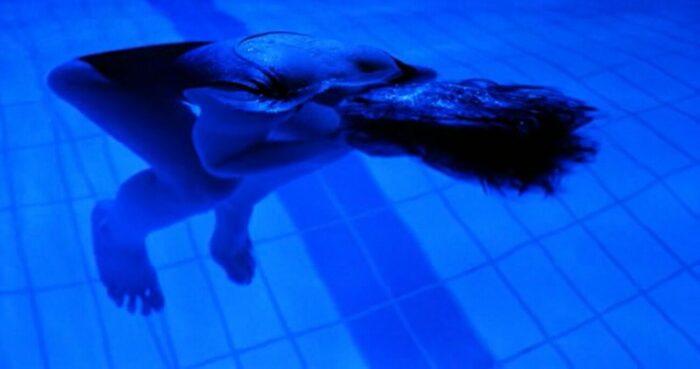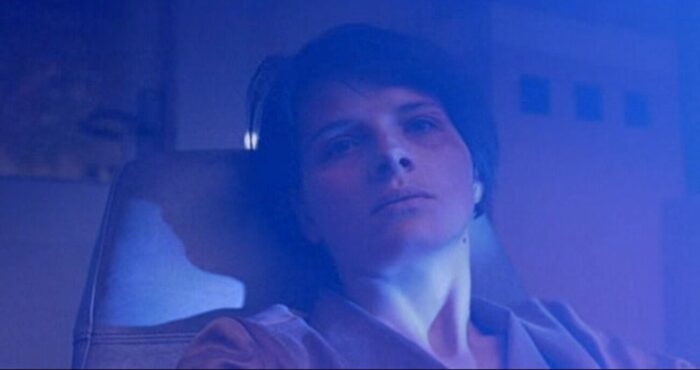The first film of Krzysztof Kieślowski‘s Three Colors trilogy, Blue tells the story of gaining freedom from the past through confronting grief, letting the pain go, and starting to look forward. Each of these three films is associated with different colors of the French tricolor and the ideals of the French Revolution. Blue represents the idea of Liberty. Blue prevails in the film’s color palette. And blue is the color of both the main character’s grief and her liberation in the end.
Kieślowski, in my personal opinion, is one of the best directors in terms of the expression of emotions through the combination of visuals and sound. This applies to Blue as well, where grief and sorrow are expressed through color, visual details or effects, accompanied by deeply touching, at times overwhelming music composed by Zbigniew Preisner. Added to this, the superb performance of Juliette Binoche who plays the main character, Julie.
The film starts with a car accident as a result of which Julie loses her husband and daughter. After attempting suicide and realizing that she is unable to do it, she decides to cut all ties with her past life, including all the people in it. Julie arranges the house to be sold and her closest people taken care of. Then rents an apartment in Paris and moves there, without letting anyone know her new address.
‘Now I have just one thing left to do: nothing. I want no possessions, no memories, no friends, no lovers — they’re all traps,’ Julie tells her mother (Emmanuelle Riva) who has, in fact, Alzheimer’s disease and doesn’t recognize her.
Julie’s husband, Patrice, was a famous composer. He was writing the concerto dedicated to the unification of Europe. It is hinted that Julie was actively involved in her husband’s work, though never credited. In any case, she is the only one who would know what Patrice wanted to say with his music. But she refuses to finish it. Before moving, Julie destroys the partiture of the concerto, as it is also one of those things that connect her with her past life. However, she’s unaware that the partiture has been copied, which later in the film makes it possible to finish the concerto.
The last thing Julie does before leaving is that she sleeps with Olivier (Benoît Régent), her husband’s assistant, who she knows to be in love with her. doing this, Julie wants Olivier not to think about her anymore.
As I said above, Julie cuts all the ties but there are two things she takes with her. One is a blue ceiling pendant. And the other is a piece of paper where Patrice had written down the motif he wanted to use in the concerto finale. Though we only find out about this one near the end of the film.
These are two things from her past that Julie keeps. The blue ceiling pendant is an apparent, visible one, that is in the center of the frame very often. And the music is what we repeatedly hear, as it sounds in Julie’s mind, who is unable to forget it.
Though there is another piece of music as well—the funeral motif, which is a direct reminder of her loss. This motif also undergoes change throughout the film, representing the changes taking place in Julie.
Below I will discuss these two (visual and musical) symbols and ideas linked to them, separately. Both of them are connected to memories but in a somewhat different manners.
Ceiling pendant—memories and grief
This pendant consisting of a mirror and hanging blue beads apparently belonged to Julie’s daughter. The first thing Julie does when she arrives in a new apartment is to hang this pendant on the ceiling. It is the link to the past, the times when her daughter was alive. Small pieces of glass, or maybe of memories, held together with a thin thread. But at the same time, it is the bridge to the future, and to liberty. Julie’s new neighbor, Lucille (Charlotte Véry), describes a similar pendant that she has as a child, and how she used to lie down on the floor under it and try to reach it. ‘Then I forgot it’, she adds. Was it because she grew up and forgot her dreams too?

If you look from a close distance, these blue beads of the pendant also block the full view. As if through them one can see only glimpses, perhaps, of the future or the past, depending on the perspective.
We often see glass and reflections in the film. Windows, screens, often reflecting blue light. Reflections are in the scenes of Julie with her mother, and in the exotic dance club scene with Lucille. Through glasses, she sees Olivier on TV and finds out about the saved copy of the concerto, as well as about her husband’s mistress.
There is one more reflecting surface in the film—water. But in this case, it’s not just a reflection. It allows immersion. Every time Julie has to deal with the past and relive the pain, she goes to the swimming pool, immerses herself in the blue of the water, becoming part of that reflection of the past and her pain.

The concerto has a choir where the text from the letter of Saint Paul is used as lyrics. Specifically, it’s the excerpt where he talks about divine love. Though these exact words are not included in the concerto, it’s hard not to think about the line: “For now we see only a reflection as in a mirror; then we shall see face to face.” The ceiling pendant is of glass too, and it allows seeing through it only in parts. And when you look at it from below, it has a mirror.
Memento—memories and liberation
There is another thing Julie takes with her. We learn about it only closer to the end. The piece of paper where Patrice wrote down the motif of ‘memento’, as he called it. She includes this motif in the finale of the concerto, as Patrice was going to do.
Julie’s liberation from her grief and the past is reflected in the music. Two motifs—as we later learn, from the music of fictional composer Van Den Budenmayer—are repeatedly heard throughout the film. The first is the funeral music which is linked to Julie’s grief and the memories of her loss. The second is ‘memento’.
These two motifs change throughout the film. Funeral music is aggressive in the beginning, accompanied by the intense blue color that fills the frame—as if hitting Julie with grief.

This motif is heard several times afterwards when Julie is reminded of her loss. Then it is mixed with the memento motif. And finally, disappears after Julie meets her husband’s mistress, which means she decides to confront the past.
The memento motif is developing the other way round. We hear it for the first time when Julie finds the sheet. She’s, actually, looking for it. Its fragments are heard as the reminiscence of her past life when Julie hangs the pendant in her new apartment. This motif keeps Julie connected to the music and reminds her that she has to finish the concerto. She resists the thought until she finds out that the music was copied and saved.
Gradually ‘memento’ becomes the motif for letting go of grief. It becomes the symbol of Julie’s liberation through the music which, in fact, she finishes sitting under that pendant.
Return to life and reflection of love
While Julie still refuses to look back, gradually some things from the past, that she is unaware of, start catching up with her. The boy who witnessed the accident returns a golden chain with the cross—the gift from her husband that she has forgotten after the accident. She finds out about Patrice’s mistress, Sandrine (Florence Pernel), who turns out to be pregnant with his son. Julie decides to give the house to Sandrine and her son, instead of selling it. Thus leaving it behind and giving Patrice’s son the name and house, as a legacy of his father.
Olivier locates Julie after months of search and impels her to face the fact that she needs to deal with the past and finish the concerto. Olivier himself tries to finish it. Then Julie joins to help. Like, I assume, she would do with Patrice. But Olivier refuses to take credit and suggests that Julie has to credit her name. Quite the opposite of Patrice, I would guess.
Being forced to reflect on motherhood and deal with the loss of her child, Julie starts visiting her mother who has Alzheimer’s disease, and confuses Julie with her sister.
Julie has the support of Lucille, a neighbor who she helped inadvertently. If I’m not mistaken, she is the first person whose help Julie accepts. From Sandrine, we find out what Patrice thought of Julie—that she is generous and anyone can rely on her. But perhaps she had to learn to accept others’ help.
Let’s return to the choir of concerto one more time, and its praise of love. It’s the love that liberates. In Julie’s case, it was Olivier’s love that she needed to accept.
When Julie tries to kill herself after learning about the death of her husband and daughter, she breaks the window glass in order to distract the nurse. In the end, when she is with Olivier, we see Julie leaning against the glass with her face and hands, and the glass is whole. We are still looking at Julie through the glass, though this time we see her clearly, without reflections. Though it lasts only for a moment.
And finally, there’s yet another kind of reflection. After the accident, when in the hospital Julie learns about the death of her husband and daughter, we see the doctor telling her the terrible news in the reflection of her eye. From then on, Julie lives as if sees the world with that eye, filled with death and grief. Until she decides to return to life. In the end, Julie herself is reflected in Olivier’s eye, the eye of the man who loves her. It’s the reflection of love. And in the final frame, we see that blue is reflected on her face again, but this time she starts smiling. If blue was the color of grief in the beginning, now it has become the color of peace, hope, and love.




Hi Magda! Fantastic analysis! I just saw Blue again gor the first time in years. Such a magnificent film.. and you did it justice.. Question: Do you tbink Jukie is pregnant at the end? I thought i saw an image at the end of her looking at an image from a sonogram…
Hi Karen, thank you!
If you mean the image in the ending sequence, it’s Sandrine’s baby, not Julie’s.
Having just rewatched this after many years (part of a double header with Tar, which was kind of fun), a central question is whether Julie simply assisted her husband, or outright wrote his compositions. This question was much more apparent to me at least on second viewing than first.
The appearance of the musical themes are very clearly intended to be what she’s hearing in her head–from the timing, what happens on the screen (e.g. blackness), and that as soon as pov shifts to another character, the music ends. To read an orchestral partiture sketch of another composer’s notes and hear the completed product in your head is not even common among musicians (just ask Sussmayr.)
Also, her handwriting is the same…
This and Red are such good movies.